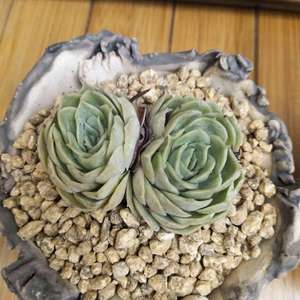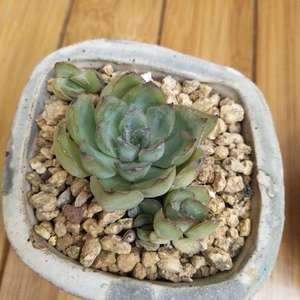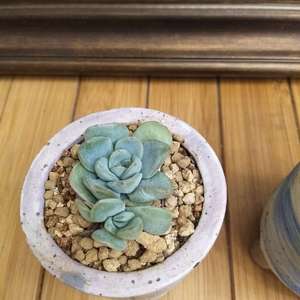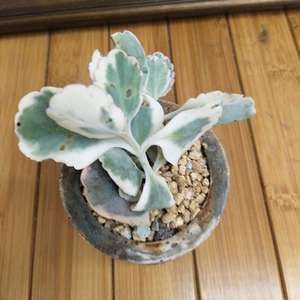辣木姐--璐颖
2018年08月16日

我新添加了一棵“劳尔2018-8-16上盆(AK多肉)¥2元入”到我的“花园”


0
0
辣木姐--璐颖:@五花肉jia鱼 买几颗玩玩,过几天云南大大家的肉到货都是巨无霸
五花肉jia鱼:这家也光顾了
文章
Miss Chen
2018年08月09日

Description: This plant is a summer annual about 3-5' tall that branches dichotomously. The stems are green or purple and largely hairless, although young stems often have conspicuous hairs. The alternate leaves are up to 8" long and 6" across (excluding the petioles). They are ovate or ovate-cordate in outline, but pinnately lobed. These lobes are somewhat shallow and pointed at their tips; there are usually 2-3 of these lobes on each side of the leaf blade. The margin of each leaf may have a few secondary lobes or coarse dentate teeth, otherwise it is smooth or slightly undulate. The leaves may be slightly pubescent when young, but become hairless with age; the upper surface of each leaf is often dark green and dull. The foliage of Jimsonweed exudes a bitter rank odor.
Individual flowers occur where the stems branch dichotomously; the upper stems also terminate in individual flowers. The funnelform corolla of each flower is up to 5" long and 2" across when fully open; its outer rim has 5 shallow lobes. Each of these lobes forms an acute point in the middle.The corolla is white or pale violet throughout, except at the throat of the flower, where thick veins of dark violet occur. The light green calyx is shorter than the corolla and conspicuously divided along its length by 5 membranous wings. The blooming period occurs from mid-summer to early fall and lasts about 2 months. The flowers usually don't open up until midnight and close early in the morning; less often, the flowers may bloom toward the middle of the day, especially when it is cloudy. Individual flowers last only a single day. Each flower is replaced by a hard fruit that is dry and spiny; it is about 1½" long, 1" across, and spheroid-ovoid in shape. Underneath each fruit is a truncated remnant of the calyx that curves sharply downward. These fruits are initially green, but become brown with maturity; they divide into 4 segments to release the seeds. The large seeds are dull, irregular, and dark-colored; their surface may be pitted or slightly reticulated. The root system consists of taproot that is shallow for the size of the plant; it branches frequently. Jimsonweed spreads by reseeding itself.

Cultivation: The preference is full or partial sun, moist to mesic conditions, and a rich fertile soil with high nitrogen content. This type of soil is necessary to supply the nutrients that are required by the prodigious growth of this annual plant. The foliage is often pitted by tiny holes that are made by flea beetles (the same or similar species that attack eggplant). The seeds can remain viable in the ground for several years.
Range & Habitat: Jimsonweed is a fairly common plant that has been observed in most counties of Illinois (see Distribution Map). It is probably adventive from tropical America and it was first observed in the United States at the Jamestown colony during the 17th century. Typical habitats include cropland (particularly corn fields), fallow fields, old feed lots, piles of soil at construction sites, mounds of decomposed mulch and discarded vegetation, urban vacant lots, and miscellaneous waste areas. Disturbed areas with open fertile soil are strongly preferred.

Faunal Associations: The flowers are cross-pollinated by nectar-seeking Sphinx moths. Various species of beetles are attracted by the flowers, especially at night, where they steal nectar and chomp on the pollen. The foliage and other parts of Jimsonweed are a source of food for several flea beetles (Epitrix spp.), Three-lined Potato Beetle (Lema daturaphila), Colorado Potato Beetle (Leptinotarsa decemlineata), Clavate Tortoise Beetle (Plagiometriona clavata), and larvae of the Pink-spotted Hawk Moth (Agrius cingulata); see Clark et al. (2004) and Covell (1984/2005). The foliage and seeds contain an impressive assortment of toxic alkaloids that can be fatal to mammalian herbivores and humans. Some of these alkaloids are mildly narcotic and hallucinogenic. The immature seeds are especially poisonous; as few as 20 seeds can fatally poison a child. It is doubtful that birds make any use of these toxic seeds. Humans help to spread the seeds around through activities that are related to agriculture, construction, and landscaping.

Photographic Location: Near piles of soil at a vacant lot in Champaign, Illinois. These piles of soil were dumped and occasionally carried off by trucks in relation to off-site construction and landscaping activities.
Comments: The common name 'Jimsonweed' is probably a corruption of 'Jamestown Weed,' referring to where this species was first observed in North America. Another common name that is often used for this species is 'Thornapple.' Two varieties of Jimsonweed have been described. The typical variety has green stems and white flowers, while var. tatula has purple stems and either pale violet or purple-striped flowers. Jimsonweed has a distinct appearance, making it easy to identify.

The only other Datura spp. in Illinois, Datura wrightii (Angel's Trumpet), rarely naturalizes in the wild. It is sometimes cultivated in flower gardens because of its attractive flowers. Angel's Trumpet is a hairier plant with unlobed leaves and larger flowers. The corolla of its flowers ranges from 5-8" in length, while the corolla of Jimsonweed's flowers is about 3–5" in length. Both of these Datura spp. have flowers that bloom during the night. Another species in the Nightshade family, Nicandra physalodes (Shoofly Plant), also rarely naturalizes in the wild. The Shoofly Plant has foliage that is similar to Jimsonweed, but its funnelform flowers are much smaller (less than 1½" long and across). Unlike Jimsonweed, the flowers of Shoofly Plant are strictly diurnal.
Individual flowers occur where the stems branch dichotomously; the upper stems also terminate in individual flowers. The funnelform corolla of each flower is up to 5" long and 2" across when fully open; its outer rim has 5 shallow lobes. Each of these lobes forms an acute point in the middle.The corolla is white or pale violet throughout, except at the throat of the flower, where thick veins of dark violet occur. The light green calyx is shorter than the corolla and conspicuously divided along its length by 5 membranous wings. The blooming period occurs from mid-summer to early fall and lasts about 2 months. The flowers usually don't open up until midnight and close early in the morning; less often, the flowers may bloom toward the middle of the day, especially when it is cloudy. Individual flowers last only a single day. Each flower is replaced by a hard fruit that is dry and spiny; it is about 1½" long, 1" across, and spheroid-ovoid in shape. Underneath each fruit is a truncated remnant of the calyx that curves sharply downward. These fruits are initially green, but become brown with maturity; they divide into 4 segments to release the seeds. The large seeds are dull, irregular, and dark-colored; their surface may be pitted or slightly reticulated. The root system consists of taproot that is shallow for the size of the plant; it branches frequently. Jimsonweed spreads by reseeding itself.

Cultivation: The preference is full or partial sun, moist to mesic conditions, and a rich fertile soil with high nitrogen content. This type of soil is necessary to supply the nutrients that are required by the prodigious growth of this annual plant. The foliage is often pitted by tiny holes that are made by flea beetles (the same or similar species that attack eggplant). The seeds can remain viable in the ground for several years.
Range & Habitat: Jimsonweed is a fairly common plant that has been observed in most counties of Illinois (see Distribution Map). It is probably adventive from tropical America and it was first observed in the United States at the Jamestown colony during the 17th century. Typical habitats include cropland (particularly corn fields), fallow fields, old feed lots, piles of soil at construction sites, mounds of decomposed mulch and discarded vegetation, urban vacant lots, and miscellaneous waste areas. Disturbed areas with open fertile soil are strongly preferred.

Faunal Associations: The flowers are cross-pollinated by nectar-seeking Sphinx moths. Various species of beetles are attracted by the flowers, especially at night, where they steal nectar and chomp on the pollen. The foliage and other parts of Jimsonweed are a source of food for several flea beetles (Epitrix spp.), Three-lined Potato Beetle (Lema daturaphila), Colorado Potato Beetle (Leptinotarsa decemlineata), Clavate Tortoise Beetle (Plagiometriona clavata), and larvae of the Pink-spotted Hawk Moth (Agrius cingulata); see Clark et al. (2004) and Covell (1984/2005). The foliage and seeds contain an impressive assortment of toxic alkaloids that can be fatal to mammalian herbivores and humans. Some of these alkaloids are mildly narcotic and hallucinogenic. The immature seeds are especially poisonous; as few as 20 seeds can fatally poison a child. It is doubtful that birds make any use of these toxic seeds. Humans help to spread the seeds around through activities that are related to agriculture, construction, and landscaping.

Photographic Location: Near piles of soil at a vacant lot in Champaign, Illinois. These piles of soil were dumped and occasionally carried off by trucks in relation to off-site construction and landscaping activities.
Comments: The common name 'Jimsonweed' is probably a corruption of 'Jamestown Weed,' referring to where this species was first observed in North America. Another common name that is often used for this species is 'Thornapple.' Two varieties of Jimsonweed have been described. The typical variety has green stems and white flowers, while var. tatula has purple stems and either pale violet or purple-striped flowers. Jimsonweed has a distinct appearance, making it easy to identify.

The only other Datura spp. in Illinois, Datura wrightii (Angel's Trumpet), rarely naturalizes in the wild. It is sometimes cultivated in flower gardens because of its attractive flowers. Angel's Trumpet is a hairier plant with unlobed leaves and larger flowers. The corolla of its flowers ranges from 5-8" in length, while the corolla of Jimsonweed's flowers is about 3–5" in length. Both of these Datura spp. have flowers that bloom during the night. Another species in the Nightshade family, Nicandra physalodes (Shoofly Plant), also rarely naturalizes in the wild. The Shoofly Plant has foliage that is similar to Jimsonweed, but its funnelform flowers are much smaller (less than 1½" long and across). Unlike Jimsonweed, the flowers of Shoofly Plant are strictly diurnal.
0
0
绝骨
2018年08月02日

18年8月2日,帝都,爆热。迎来了4位新成员:半球,果冻,冰玉,达摩。总之折腾了1个多小时,种上了。说实在的,这两天买还不如一个月前暴雨时候买,至少那会儿凉快啊!但是手欠啊!就买了哈哈哈。放在没直晒又通风的北窗台,晾着。听天由命。


1
0
文章
Miss Chen
2018年07月30日

Description: This plant is an annual about 3-8" tall that branches occasionally, and it is more or less erect. The stems, leaves, and calyx of the flowers are greyish green and hairless. The slender stems are irregularly angular. The opposite leaves are up to 1" long and ¾" across, becoming smaller as they ascend the stems. They are variably shaped, smooth along the margins, and sessile or slightly clasping the stems. The lower leaves are ovoid or ovate with blunt tips, while the upper leaves are often lanceolate or oblong. Their texture is slightly fleshy and succulent. There is no tuft of basal leaves at the base of the plant. The upper stems terminate in small cymes or flat-headed panicles of flowers; some cymes of flowers may be produced from the axils of the upper leaves as well. Each flower has a narrow tubular corolla that is about ½" long; at its apex, this corolla divides into 5 spreading lobes up to ¼" across. These petal-like lobes are narrow and pink. At the base of the flower, there is a tubular calyx with 5 lobes that are very narrow and long. These calyx lobes are appressed against the base of the tubular corolla and at least half its length (sometimes they are nearly as long as the corolla). At the narrow throat of the flower, there are several exserted stamens with yellow anthers. Each flower has a short pedicel at least 1/8" long. The blooming period occurs during the summer and early fall and lasts about 2-3 months. As older flowers begin to fade away, the area that is enclosed by the lobes of their calyxes begins to swell until ovoid seed capsules are formed. Each seed capsule is open at the top and has 5 recurved teeth along its upper rim. Each of these capsules contains several tiny seeds that can be blown about by the wind or float on water. The root system consists of shallow fibrous roots. This plant spreads by reseeding itself.
Cultivation: Typical growing conditions are full sun and a moist soil that contains loam, clay-loam, or gravelly material. A limy soil and occasional flooding are tolerated.
Range & Habitat: Branching Centaury is an uncommon plant that is originally from Europe. It occurs primarily in a few counties in NE Illinois and does not appear to be spreading (see Distribution Map). The webmaster recently found a small colony of plants growing in Champaign County, Illinois. Habitats include moist depressions in grassy areas along roads and railroads. So far, this species is restricted to highly disturbed habitats.
Faunal Associations: Little information about floral-faunal relationships is available for this species. The structure of the flowers suggests that long-tongued bees, small butterflies, and skippers occasionally pollinate the flowers. One likely candidate is the butterfly Pieris rapae (Cabbage White), which is originally from Europe. The foliage of plants in the Gentian family is usually bitter and unattractive to most herbivores, although rabbits may nibble on the stems and leaves of Branching Centaury occasionally. The seeds are too small to be of much interest to birds.
Photographic Location: A moist grassy depression that was located a short distance away from a railroad in Urbana, Illinois. This area was mowed irregularly and prone to temporary flooding.

Comments: Branching Centaury is a small plant with delicate pink flowers. It has many characteristics in common with members of the Pink family (Caryophyllaceae), but it differs in having a calyx with long slender lobes that are at least half the length of the tubular corolla. According to official records, this is the only Centaurium sp. that has naturalized in Illinois. Some south-central and southwestern states have native Centaurium spp., but none of them have been observed in Illinois. These native species tend to have somewhat larger flowers and more narrow lower leaves. A closely related species from Europe, the biennial Centaurium erythraea (Forking Centaury), has been observed in Indiana and may occur somewhere in Illinois. The inflorescence of this latter species is less flat-headed and more vertical, while its flowers have shorter calyx lobes and slightly longer corolla lobes. The Centaurium spp. differ from the closely related Sabatia spp. (Rose Pinks) by having smaller flowers that are longer than they are across; they are always narrowly tubular at the base. The flowers of Rose Pinks have more open corollas with larger petal-like lobes, while the lobes of their calyxes are more spreading.
Cultivation: Typical growing conditions are full sun and a moist soil that contains loam, clay-loam, or gravelly material. A limy soil and occasional flooding are tolerated.
Range & Habitat: Branching Centaury is an uncommon plant that is originally from Europe. It occurs primarily in a few counties in NE Illinois and does not appear to be spreading (see Distribution Map). The webmaster recently found a small colony of plants growing in Champaign County, Illinois. Habitats include moist depressions in grassy areas along roads and railroads. So far, this species is restricted to highly disturbed habitats.
Faunal Associations: Little information about floral-faunal relationships is available for this species. The structure of the flowers suggests that long-tongued bees, small butterflies, and skippers occasionally pollinate the flowers. One likely candidate is the butterfly Pieris rapae (Cabbage White), which is originally from Europe. The foliage of plants in the Gentian family is usually bitter and unattractive to most herbivores, although rabbits may nibble on the stems and leaves of Branching Centaury occasionally. The seeds are too small to be of much interest to birds.
Photographic Location: A moist grassy depression that was located a short distance away from a railroad in Urbana, Illinois. This area was mowed irregularly and prone to temporary flooding.

Comments: Branching Centaury is a small plant with delicate pink flowers. It has many characteristics in common with members of the Pink family (Caryophyllaceae), but it differs in having a calyx with long slender lobes that are at least half the length of the tubular corolla. According to official records, this is the only Centaurium sp. that has naturalized in Illinois. Some south-central and southwestern states have native Centaurium spp., but none of them have been observed in Illinois. These native species tend to have somewhat larger flowers and more narrow lower leaves. A closely related species from Europe, the biennial Centaurium erythraea (Forking Centaury), has been observed in Indiana and may occur somewhere in Illinois. The inflorescence of this latter species is less flat-headed and more vertical, while its flowers have shorter calyx lobes and slightly longer corolla lobes. The Centaurium spp. differ from the closely related Sabatia spp. (Rose Pinks) by having smaller flowers that are longer than they are across; they are always narrowly tubular at the base. The flowers of Rose Pinks have more open corollas with larger petal-like lobes, while the lobes of their calyxes are more spreading.
0
0
文章
Miss Chen
2018年07月25日

Description: This plant is a summer annual that becomes 2-8' tall, branching occasionally. The stems are usually glabrous and glaucous; sometimes they have scattered stiff hairs toward the base. The alternate leaves are up to 10" long and 3" across, becoming smaller as they ascend the stems. The lower leaves are pinnately lobed and obovate in outline, tapering to a long and rather stout petiole. The terminal lobe is much larger than the lateral lobes. The upper surface of a lower leaf is often bristly with scattered hairs that are stiff, short, and white. The lower surface is usually glabrous, except for a few hairs along the central vein. The upper leaves are often lanceolate, broadly elliptic, or some other odd shape; they have 1-2 lobes or none.
The upper stems terminate in narrow racemes of yellow flowers; these racemes are ½–2' long when fully mature. Each flower is up to 1/3" (8 mm.) across, consisting of 4 yellow petals, 4 sepals, several stamens, and a pistil. The sepals are initially green, but become yellow while the flower blooms. The petals are well-rounded toward their tips. The blooming period occurs primarily during the summer and lasts about 1-2 months. A few plants may bloom during the fall. Each flower is replaced by a slender silique that becomes appressed against the stalk of the raceme as it matures. This silique is about 2/3" (17 mm.) long, tapering to a conical beak. The petiole of the silique (or flower) is about 1/3" (8 mm.) long. The seeds within this silique are dark brown or black. Both the seeds and the foliage have a pungent taste. The root system consists of a taproot. This plant spreads by reseeding itself.

Cultivation: This plant often occurs in full or partial sun, fertile soil, and mesic conditions. On less fertile ground, it is smaller in size. During hot sunny weather the leaves have a tendency to wilt, but they quickly recover by nightfall. Sometimes this plant becomes lanky and flops sideways.
Range & Habitat: The non-native Black Mustard is a common plant in central and northern Illinois, but it is less common or absent in southern Illinois (see Distribution Map). Habitats include weedy meadows, thickets, areas along railroads and roadsides, fallow fields, vacant lots, and miscellaneous waste places. Disturbed areas are preferred; Black Mustard doesn't invade high quality natural areas to any significant degree. It is native to Eurasia.

Faunal Associations: The nectar and pollen of the flowers attract primarily small bees and flower flies; less common visitors include White butterflies and wasps. The foliage is occasionally eaten by the caterpillars of various White butterflies, including Pieris rapae (Cabbage White) and Pontia protodice (Checkered White). The pungent foliage is usually avoided by mammalian herbivores; it is somewhat toxic to them.
Photographic Location: Along a railroad in a partially shaded area in Urbana, Illinois.

Comments: If you see a lanky mustard plant with narrow stalks of yellow flowers that is over your head, there's a good chance that it's Black Mustard. The seeds of Black Mustard are often used in the table condiment, hot mustard. Among the many Brassica spp. and Synapis spp. (Mustards), Black Mustard can be identified by considering the following characteristics: 1) It is often quite tall, 2) the slender siliques are appressed together near the stalk of each raceme, 3) the siliques are less than ¾" long and they have distinct beaks, 4) the leaves narrowly clasp the stems, 5) the terminal lobes of the lower leaves are much larger than the lateral lobes, and 6) the lower leaves often have short stiff hairs and feel bristly to the touch. Other mustards are often lacking one or more of these features.
The upper stems terminate in narrow racemes of yellow flowers; these racemes are ½–2' long when fully mature. Each flower is up to 1/3" (8 mm.) across, consisting of 4 yellow petals, 4 sepals, several stamens, and a pistil. The sepals are initially green, but become yellow while the flower blooms. The petals are well-rounded toward their tips. The blooming period occurs primarily during the summer and lasts about 1-2 months. A few plants may bloom during the fall. Each flower is replaced by a slender silique that becomes appressed against the stalk of the raceme as it matures. This silique is about 2/3" (17 mm.) long, tapering to a conical beak. The petiole of the silique (or flower) is about 1/3" (8 mm.) long. The seeds within this silique are dark brown or black. Both the seeds and the foliage have a pungent taste. The root system consists of a taproot. This plant spreads by reseeding itself.

Cultivation: This plant often occurs in full or partial sun, fertile soil, and mesic conditions. On less fertile ground, it is smaller in size. During hot sunny weather the leaves have a tendency to wilt, but they quickly recover by nightfall. Sometimes this plant becomes lanky and flops sideways.
Range & Habitat: The non-native Black Mustard is a common plant in central and northern Illinois, but it is less common or absent in southern Illinois (see Distribution Map). Habitats include weedy meadows, thickets, areas along railroads and roadsides, fallow fields, vacant lots, and miscellaneous waste places. Disturbed areas are preferred; Black Mustard doesn't invade high quality natural areas to any significant degree. It is native to Eurasia.

Faunal Associations: The nectar and pollen of the flowers attract primarily small bees and flower flies; less common visitors include White butterflies and wasps. The foliage is occasionally eaten by the caterpillars of various White butterflies, including Pieris rapae (Cabbage White) and Pontia protodice (Checkered White). The pungent foliage is usually avoided by mammalian herbivores; it is somewhat toxic to them.
Photographic Location: Along a railroad in a partially shaded area in Urbana, Illinois.

Comments: If you see a lanky mustard plant with narrow stalks of yellow flowers that is over your head, there's a good chance that it's Black Mustard. The seeds of Black Mustard are often used in the table condiment, hot mustard. Among the many Brassica spp. and Synapis spp. (Mustards), Black Mustard can be identified by considering the following characteristics: 1) It is often quite tall, 2) the slender siliques are appressed together near the stalk of each raceme, 3) the siliques are less than ¾" long and they have distinct beaks, 4) the leaves narrowly clasp the stems, 5) the terminal lobes of the lower leaves are much larger than the lateral lobes, and 6) the lower leaves often have short stiff hairs and feel bristly to the touch. Other mustards are often lacking one or more of these features.
0
0















